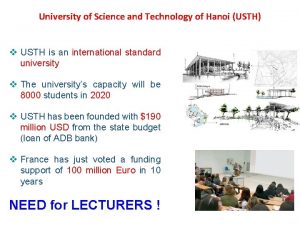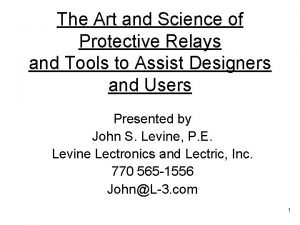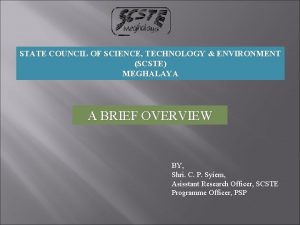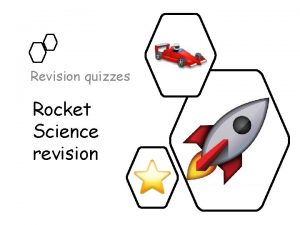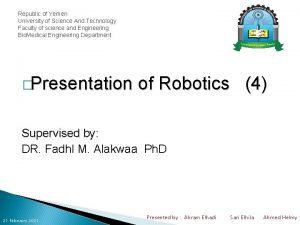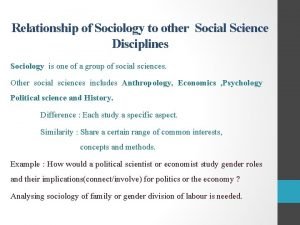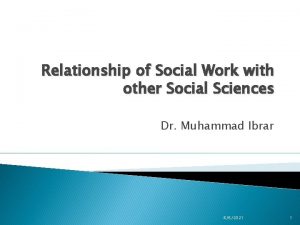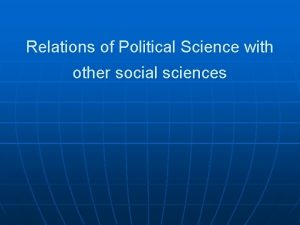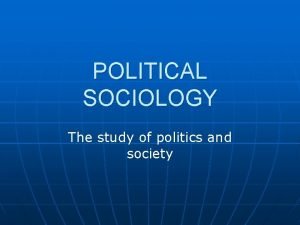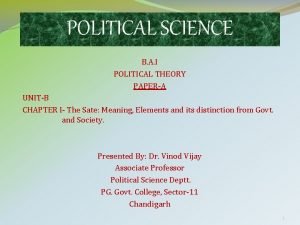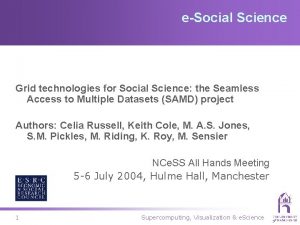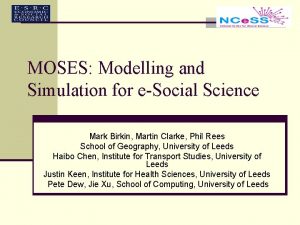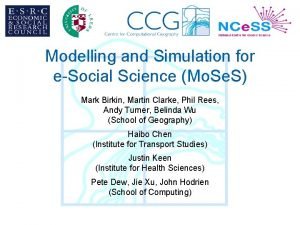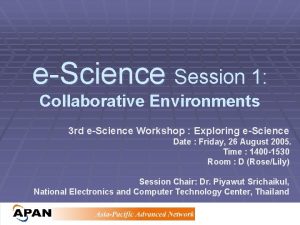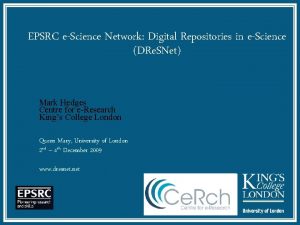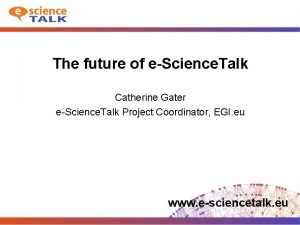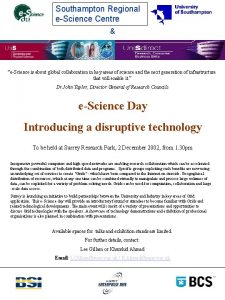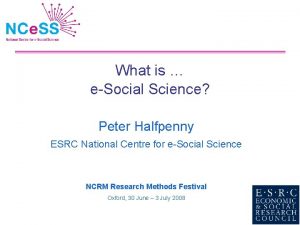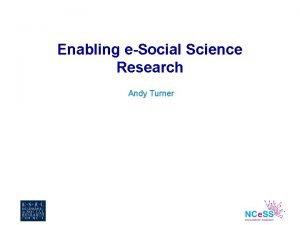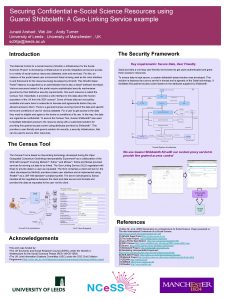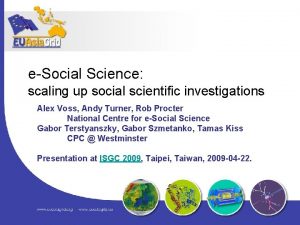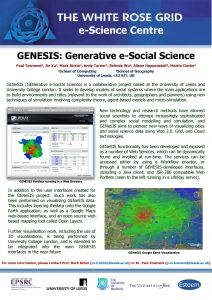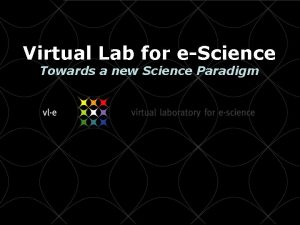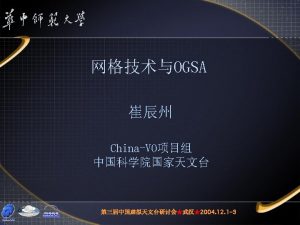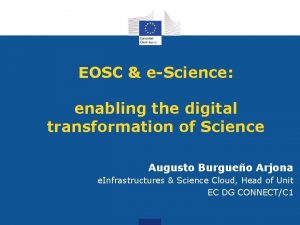ESocial Science What is eScience EScience and eSocial





























- Slides: 29

E-Social Science • What is e-Science? • E-Science and e-Social Science • E-Social Science and Longitudinal Data • Examples of the Computational Problems we Currently Face (BHPS, YCS) • Existing Web Based Tools and Possible New Tools • Need for a VRE • The e-Social Science Program

What is e-Science? The technology: the three exponentials • Computer speed doubles every 18 months. Our ability to model and simulate complex systems increases at the same rate; • Storage density doubles every 12 months. Some groups talking about data sets that are a Petabyte in size and which will be 10 Petabytes/year in 5 years time; • Network bandwidth doubles every 9 months.

What is e-Science? The GRID concept puts all three components together and makes them even more important. There will be several different types of GRID, e. g. 1. Computational GRIDs for high-performance computation; 2. Access GRIDs for collaborative visualization involving distant researchers; 3. Data GRIDs for moving large volumes of data; 4. Sensor GRIDs for real-time monitoring (e. g traffic and pedestrian flows, electronic transactions);


UK e-Science Grid Glasgow Ne. SC Edinburgh (Ne. SC) DL Belfast Newcastle Manchester Cambridge Oxford Cardiff RAL London Southampton Hinxton

Some Features of Social Science Research • We want to develop evidence based substantive theory. We want to know “what determines what”, e. g. long term unemployment and social exclusion • We want to explore the consequences of policy changes on individual behaviour, e. g. encouragement to stay on at school on educational attainment, truancy, and social exclusion • Data may be small (<10 GB) but they are complex

Some Generic Features of Social Research

Cluster Effects (CE) • Most large scale longitudinal surveys use multistage sample designs to obtain 'representative' samples; this procedure often creates cluster effects, e. g. BHPS (households), YCS (schools). • Elaborate procedures have been developed to take cluster effects into account by means of shared random effects in the model e. g. MLwi. N, Stata (Gllamm). • The estimation of non-identity link CE models, e. g. probit, are computationally demanding. The quick approximations do not work in the presence of endogenous variables, e. g. conditional estimators.

Measurement Errors (ME) • Ignoring ME can seriously mislead the quantification of the link between explanatory and response variables; • In observational studies, it is rarely possible to measure all relevant covariates accurately, e. g. age, educational attainment; • ME in one covariate can bias the association between other covariates and the response variable, even if those other covariates are measured without error; • Repeated measures and longitudinal data provide the opportunity to deal with ME in explanatory variables, adds to the computational demands of the analysis.

Missing Data, Dropout and Selection • All of the major data sets available to the British social science community, such as the YCS, BHPS and NCDS, contain missing data and dropout. • It is mostly non-ignorable, non-ignorable missing data and dropout are a source of bias. • When there is missing data it is important to try and model, as realistically as possible, the process by which the observed subjects have been retained in the sample, otherwise we will not know whether the selection process has only retained subjects with certain characteristics. • Some sample designs create selection effects. • These features add to the computational demands of the analysis

Endogenous effects • The curse of endogenous effects, everything seems to depend on everything else. • We need multiprocess models to disentangle this complexity, adds to computation. • Longitudinal data can provide the opportunity to disentangle endogenous effects from correlated errors.

Take Just One of These Complications (Endogenous effects) • The YCS is a multi-stage stratified random sample of individuals ages 16 -17. • These individuals were contacted by post three times at annual intervals, at age 16 -17, 17 -18 and 18 -19 (sweeps 1, 2 and 3, respectively). • I use YCS 6 which covers young people eligible to leave school in 1990 -91 (YCS 6), who are then observed over the 1992 -94 period.

Part-time work and truancy are potential determinants of educational attainment • A comprehensive model will allow us to disentangle the observable, direct, effects of truancy on educational attainment from any effects that arise from correlation in the errors (unobserved effects).

Trivariate Ordered Probit Model (Path Diagram) Independent Errors (ep, et, eq)

Correlated Errors

Comprehensive Model Results • The direct effect of part time work on attainment changes sign • The correlation between pt-work & attainment has a different sign to the direct effect of pt-work, on attainment, the direct effect has also become significant. • The correlation between truancy & attainment, has the same sign as the direct effect of truancy, on attainment and direct effect reduced.

Problems and Model Extensions • Model takes up to a month to estimate on a P 4, 3 linear predictors, 169 parameters, 8, 496 trivariate integrals for each function evaluation. • Results change as our model becomes more comprehensive. • Need to explore other directions for the endogenous effects.

Going Parallel • Farm out the calculations for the integrals to different processors, we get linear improvements in speed; • e. g. if it takes T on one processor it takes T/200 on 200, i. e. 1 month goes to less than 4 hours. • This improvement is present all the way up to sample size, at which 1 month goes to 6 minutes.

(Existing web based tools) • Allows users to submit R jobs and get output back to their web session; • Rweb needs more menus, the extensive R statistical library, not used;

(Existing web based tools) • Allows 66 major datasets to be explored online, • Only uses one data set at a time; • Has very limited facilities for sub-setting and none for fusing; • Restricted statistical facilities, e. g. descriptive analysis, linear regression; • No facilities for handling missing data.

New Tools: Joining Up in the Analysis Cycle Main ESDS Data Sets TTWA Data, NOMIS Select Data Set and Appropriate Variables: Merge Files: Add Variables Working Data Results Contextual Data

New Tools: Linking Components Data Management A Data Management B Data Management C Analysis A Analysis B Analysis C Middleware

New Tools: Simultaneous Analysis

Check Step We need to keep our focus on the priority ordering: Scientific challenge > software > hardware • Software is more important than hardware. • Software lasts longer than hardware • Software development is lagging behind that of hardware, the ’software gap’

Problems with using the GRID • Currently requires heroic effort to use it; • GT 2 is very complicated and difficult to install; • Can make other University services vulnerable if not properly managed; • User requirements not fully articulated; • Human factors not addressed, needs familiar GUI, pull down menus, etc.

We need a Virtual Research Environment “to make the use of e-Science technologies, methodologies and resources easier and more transparent for than simply developing bespoke applications on an infrastructure toolkit (such as GT 2). ” JISC interested in funding the VRE

Functionality/ Content of the VRE

What might a VRE look like?

UK E-Social Science Programme There is a growing body of work and projects in this area: • Centre of Excellence in e-Social Science – DTI Core Programme; • Pilot projects – ESRC; • Re. DRe. SS: Resource Discovery for Researchers in e-Social Science – JISC/ ESRC; • Agenda Setting Workshops – JISC/ ESRC; • UK National Grid Service + e-Science Grid - JCSR and DTI Core Programme; • NCe. SS: National Centre for e-Social Science – ESRC; • Qe. SSSS: Quantitative e-Social Science Support Service ESRC (+ future NCe. SS nodes).
 What's your subject
What's your subject Anthropology vs sociology
Anthropology vs sociology Think central k5
Think central k5 Soft science definition
Soft science definition Natural vs social science
Natural vs social science Natural science branches
Natural science branches Natural and physical science
Natural and physical science Applied science vs pure science
Applied science vs pure science Rule of 70 in population growth
Rule of 70 in population growth Windcube lidar
Windcube lidar It is an art and science of erecting structures
It is an art and science of erecting structures Jeopardy science questions
Jeopardy science questions Kesler science crossword answer key
Kesler science crossword answer key University of science and technology of hanoi (usth)
University of science and technology of hanoi (usth) Ulsan university of science and technology
Ulsan university of science and technology The art and science of protective relaying
The art and science of protective relaying Kingdom phylum class order
Kingdom phylum class order The art and science of formulating
The art and science of formulating Scste meghalaya
Scste meghalaya Anatomy science olympiad
Anatomy science olympiad Science and technology center in ukraine (stcu)
Science and technology center in ukraine (stcu) Rocket science quiz
Rocket science quiz Science technology university yemen
Science technology university yemen Sociology is social science
Sociology is social science Relationship of social work with other social sciences
Relationship of social work with other social sciences Relation between political science and sociology
Relation between political science and sociology Queens college in thanjavur
Queens college in thanjavur Queens college
Queens college Sociology vs political science
Sociology vs political science Relationship between political science and sociology
Relationship between political science and sociology













